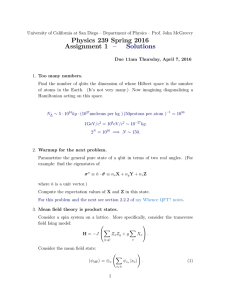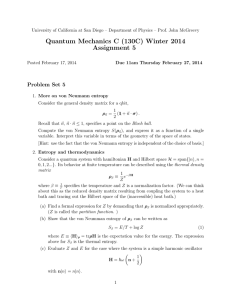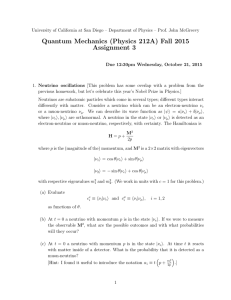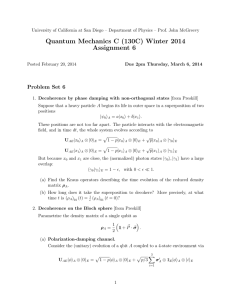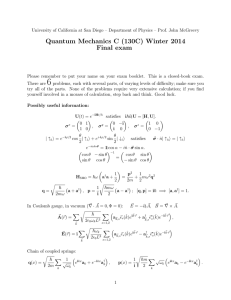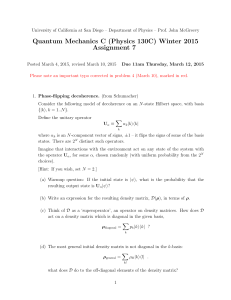Quantum Mechanics C (130C) Winter 2014 Midterm exam
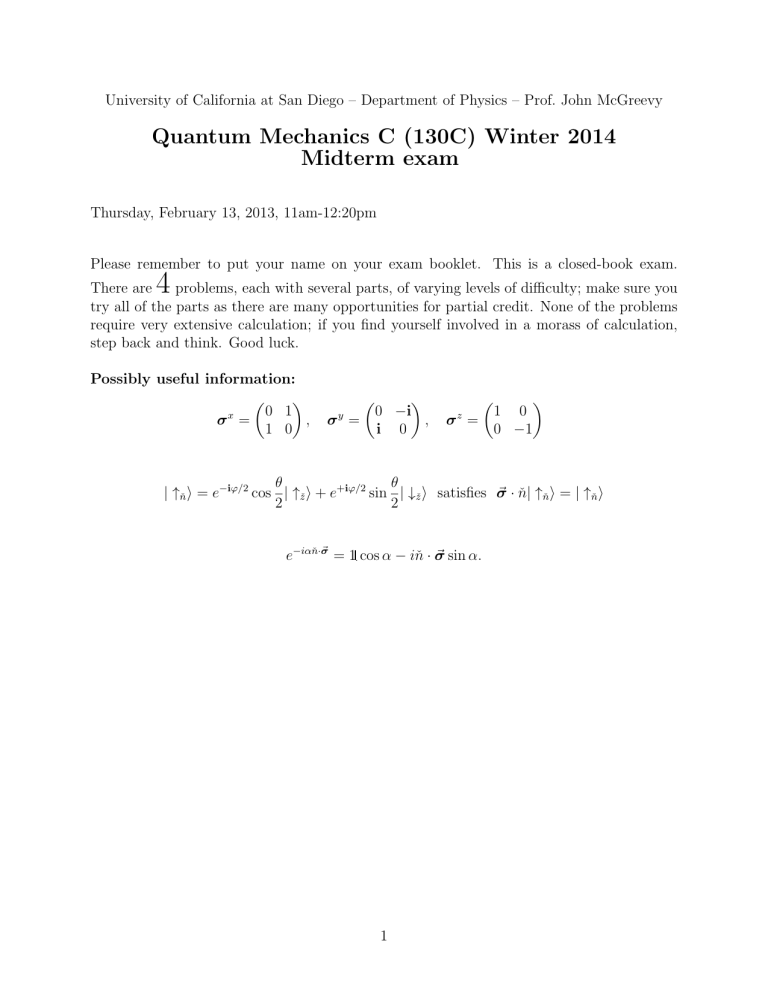
University of California at San Diego – Department of Physics – Prof. John McGreevy
Quantum Mechanics C (130C) Winter 2014
Midterm exam
Thursday, February 13, 2013, 11am-12:20pm
Please remember to put your name on your exam booklet. This is a closed-book exam.
There are
4 problems, each with several parts, of varying levels of difficulty; make sure you try all of the parts as there are many opportunities for partial credit. None of the problems require very extensive calculation; if you find yourself involved in a morass of calculation, step back and think. Good luck.
Possibly useful information:
σ x
=
0 1
1 0
, σ y
=
0 − i i 0
, σ z
=
1 0
0 − 1
| ↑ i = e
− i ϕ/ 2 cos
θ
2
| ↑ i + e
+ i ϕ/ 2 sin
θ
2
| ↓ i satisfies ~ · n | ↑ i = | ↑ i e
− iα ˇ · σ
= 1 cos α − i ˇ · σ sin α.
1
1.
Short answers and conceptual questions.
[5 points each]
(a) Write the matrix representation of the operator W ≡ | ih ☼ | + | ☼ ih | in the orthonormal basis {| i , | i , | ☼ i} .
(b) Is this matrix
ρ
?
=
1 0 0
0 − 2 0
0 0 1 a possible density matrix? If not, why not?
(c) The following operators act on a 3-state system. Which of them implements a change of basis? Which can be a representation of an observable?
A ≡ | 1 ih 2 | + | 2 ih 3 | , B ≡ | 1 ih 2 | + | 2 ih 3 | + | 3 ih 1 | , C ≡ | 1 ih 1 | + i | 2 ih 1 | − i | 1 ih 2 |
(d) How many (real) parameters must we specify to determine a pure state of one qbit? How many (real) parameters must we specify to determine a mixed state of one qbit?
(e) We are given device that reliably produces qbits ( e.g.
one polarized photon, or one spin-
1
2 just σ z particle) in a pure state (unknown, but always the same). By measuring how many of the (real) parameters of this state can we determine?
(f) A two-state system A is part of a larger system, H
A
⊗ H
B
. The subsystem A is described by the density matrix ρ = 1 1. Which of the following could be the
2 state of the whole system? Please explain.
| choice 1 i = | ↑ z i
A
⊗| ↑ z i
B
| choice 2 i =
1
√
2
( | ↑ z i
A
⊗ | ↑ z i
B
+ | ↓ z i
A
⊗ | ↓ z i
B
) .
(g) In the following state of two qbits
| ?
i =
1
2
( | ↑↑i + | ↑↓i + | ↓↑i + | ↓↓i ) , are the two qbits entangled? Explain your answer. (Hint: | ↑ x i = √
2
( | ↑i + | ↓i ).)
2
2.
A spin-1 system.
[25 points]
Consider a 3-state system, H
3 elements in the given basis are
= span {| 1 i , | 0 i , | − 1 i} . Define operators whose matrix
J x
=
1
√
2
0 1 0
1 0 1
0 1 0
, J z
1 0 0
=
0 0 0
0 0 − 1
.
(a) What are the possible values one can obtain if J z is measured?
(b) Consider an eigenstate of J z h ( J x
)
2 i and ∆ J x
≡ q h ( J x
)
2 with eigenvalue 1. In this state, what are i − h J x i 2 ?
h J x i ,
Consider the state
| ψ
1 i =
1
√
2
√ i
2
| − 1 i +
1
√
2
| 0 i + | 1 i .
(c) If J z is measured in the state outcome?
| ψ
1 i , what are the probabilities for each possible
(d) If J
2 z is measured in the state | ψ
1 i and the result +1 is obtained, what is the state after the measurement? How probable was this result?
(e) (Extra credit) Find a state | ψ i such that neither measurement of J x ment of J z can possibly give zero.
nor measure-
3
3.
Spin in a magnetic field.
[25 points]
Suppose that we have a spin-1/2 particle (fixed in place) subjected to a constant magnetic field
~
= B z . This means that its Hamiltonian is
H = − µ~ ·
Assume µ and B are positive.
The spin is initially (at t = 0) in the state
| ψ (0) i = | ↑ x i .
(a) If we measure the energy of this spin at t = 0, what is the expected value? What is the uncertainty ∆ E = p h H 2 i − h H i 2 in this measurement?
(b) Find | ψ ( t ) i .
(c) Determine the probability that a measurement of σ x at time T will give +1. (Your answer should be a function of T, B, µ .)
(d) Find the smallest time ∆ t such that h ψ (0) | ψ (∆ t ) i = 0 .
Evaluate ∆ E ∆ t (and restore factors of
~
).
4
4.
Many sources of uncertainty.
[15 points]
(a) You use your qbit-making machine to produce an electron with spin up. But you forgot whether it was set to produce a particle with spin up along ˇ or along
ˇ – the two possibilities are equally likely. What density matrix would you use to describe the state of a single particle produced by the machine? What is the probability that you’ll get +1 if you measure σ z ?
(b) Next your qbit machine malfunctions. The dial is now set to produce qbits with spin up along ˇ = ˇ cos ϕ + ˇ sin ϕ , but you have no idea what is the angle ϕ . The machine keeps spitting out qbits in this state. Describe a protocol to determine the angle ϕ , and its outcome. (As always, you have your trusty Stern-Gerlach apparatus.)
(c) (Extra credit) What is the density matrix describing the state of any one qbit in the previous part of the problem? (Your answer cannot depend on the unknown value of ϕ .) In this state, how does your ignorance compare to the maximum possible amount of ignorance about the qbit?
(d) Finally, your qbit machine really goes wild. It still produces spin-up particles, but the axis flips randomly between up along ˇ z , with the two possibilities equally likely. What is the resulting density matrix, and what is the probability that you will measure any given qbit to have spin up along ˇ ? Is this the same situation as in problem
4a ? What if you are allowed to measure more
than one qbit?
5

